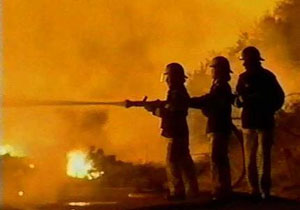SOUTH AFRICA
Article #1:
Milnerton, Cape Town. Caltex. Fire broke out at the refinery, the fourth
incident in less than a month. The manager of the refinery said the fire
happened in one of the pumps in a process unit and was extinguished within
two hours by the refinery’s emergency services teams, assisted by
fire-fighters from the Milnerton fire station. There were no injuries.
He said the refinery regretted the incident and would conduct a full investigation
into the cause. Later, black smoke was released from the refinery, but
the plant manager explained: “We are shutting down all the plants
because we had the problem with the one, so we can check everything. Unfortunately,
during the shut-down, some heavier than usual by-product might get to
the flare and produce black smoke.” The refinery was expected to
be shut for at least two weeks following the fire and major customers’
fuel supplies were to be rationed as a “precautionary measure”.
Article #2:
Running Dry: a petrol attendant is forced to turn a motorist away.

View full story here
UKRAINE
Boyarka-Ivankiv gas pipeline. Three people died and six more were injured in an explosion and fire on a gas pipeline that left 25 areas in the Zhitomir and Kiev regions, including Chernobyl, without gas. The Emergency Situations Ministry said that the fire on the pipeline had been extinguished and posed no threat to environment. All of the victims were employees of the SV-Telecom company. The gas pipeline was damaged when a communication line was being laid.
GERMANY
Wilhelmsburg, Niedersachsen. A fire broke out in a gas distribution centre and eventually led to the explosion of about thirty gas cylinders. Two men were buried under the rubble, but sustained no major injuries.
HUNGARY
Kunadacs, central Hungary. A gas explosion in a factory – variously described as "a locksmith's" and "a sawmill" – killed three people and injured nine others. Officials said it was likely the explosion involved gas from welding equipment. The blast completely levelled the building, and the search for others trapped beneath the debris continued after the dead and injured were removed
AUSTRALIA
Article #1:
Brisbane. A worker was injured when a 10m high gas cylinder exploded
at the Murarrie gas plant. A Queensland Fire and Rescue Service spokesman
said the man was hospitalised with burns to his face. He said the fire
was under control: “We’ve shut down the primary and secondary
valves and isolated that section of the plant from the remainder of the
plant and we’re filling the lines with nitrogen to make the situation
safe.”
View full story here
Article #2:

Three lanes of the Westgate Freeway have been opened with one lane remaining
closed, according to a VicRoads spokesman. Speaking at 5.10pm, the spokesman
said the third outbound lane had been opened to deal with the afternoon
peak. The Millers Road off-ramp was re-opened shortly before 5pm although
the on-ramp remained closed. The on-ramp will most likely be closed until
weekend. At the moment, outbound traffic stretches back over the Westgate
Bridge. "The queue probably goes back to the Shell service station
on the city side," he said. Inbound traffic is moving smoothly.Traffic
is banking up on the outbound lanes of the bridge, the spokesman said.
"It's basically slow at the moment, from the top of the Westgate
(Bridge), all the way out." Police have opened an investigation into
the crash. Police said just before 4am this morning a petrol tanker apparently
hit the rear of a car that had either stopped or was travelling slowly
in the outbound lanes of the freeway at Altona North. The tanker then
crashed over the side of the freeway and exploded, sending flames 30-metres
into the air.
The truck driver managed to cut himself free but the driver of the car
was killed. Three car passengers and the truck driver were taken to hospital.
Inbound lanes, bringing commuters into the city from the western suburbs,
were opened in time for the morning peak. But the spokesman said that
the outbound lanes of the freeway will probably not be open until 4pm.
At 3pm, emergency crews were still decanting fuel, removing it from the
crashed truck and into another tanker. The burnt-out shell of the tanker
is also being removed. The diversion had this afternoon caused a gridlock
on the Westgate Bridge from Todd Road on the the eastern side of the bridge
to Williamstown Road on the western end. Traffic is being merged from
four lanes to two.
A local resident, whose house is about 30 metres from where the accident
occurred, was woken in the middle of the night by the explosion. "It
woke me up all right," he said. "I was asleep and I heard a
big sound, like an explosion." "My wife got out of bed saw the
fire just before another explosion happened." The local resident
said most of his neighbours in Langshaw Street went outside to see what
was going on. He said the flames were at least 25 metres high, creating
significant radiant heat. "I was scared so I had the garage door
open in case anything happened. You can't muck around with a fire."
The resident said fuel from the tanker had seeped into drains under the
road and subsequently ignited. He saw flames roaring out of the storm
water drains. The drains are now stained with black, charcoal-like marks
from the fire. "You see things like this on TV but you don't think
it's real, but then you see it in real life." The local resident
and his other neighbours in the street have been without electricity after
the flames melted overhead power lines next to the road. A resident who
lives close to the spot where the explosion occured said she was evacuated
after hearing a huge explosion. "(It was) just like dynamite exploding,''
she told radio station 3AW. "I looked out my window and there was
this massive flame... directly in front of my house. It looked like the
freeway was on fire."
USA
Article #1:
South Whitehall Township, PA. Exxon/Mobil. An underground 200mm (8 inch)
petroleum products pipeline exploded and caught fire, forcing about 30
people to evacuate. No injuries or property damage were reported. A county
dispatcher said “a pumping station that monitors gasoline along
the pipeline” had exploded.
Emergency workers shut off a valve leading to the pipeline, and fire-fighters
were waiting for the fire to burn itself out. The Federal Aviation Administration
restricted flights in the area from entering airspace within a mile of
the explosion.
On February 2 the northern operations manager for the ExxonMobil Pipeline
Company in Fairfax, VA, said vapours the ground may have ignited when
a car drove by. Witnesses said the blast blew the bonnet [hood] off the
car. There were no injuries. According to ExxonMobil, the 200mm pipeline
splits into 100mm (4 inch) and 150mm (6 inch) pipelines in the township.
The line runs underground, but valves and monitoring equipment are above
ground at the point of explosion. The fire was reported extinguished on
February 4 after the line was tapped about 800m (half a mile) north of
the fire and the remaining gasoline was pumped out.
Article 2:
Fruit Heights, Kaysville, UT.
A tanker truck carrying butane was involved in an accident with a van
on Highway 89. Crews were preparing to offload the butane from the truck
when the tanker erupted into flames. Officials said the butane leaking
from the ruptured 3.2 tonne (7000 pounds) tanker was ignited by a source
at a nearby home. The home was destroyed and the fire followed the butane
fumes back to the tanker and started the truck on fire. No injuries were
reported.
When the accident first happened an estimated 400 people were evacuated
in the area. The evacuation expanded to about 1,500 after the tanker burst
into flames. The driver of the van was flown to hospital in serious, but
stable condition. On February 10 it was reported that flash-fires had
occurred in at least three nearby homes. The truck driver, who was hauling
butane from the Flying J Refinery, said his brakes went soft, he was unable
to stop at a red light and hit the van broadside.
Article #3:
Sebring, FL. Lesco.
A major fire broke out at the Lesco fertilizer plant at the Sebring Airport
Industrial Park. The fire began at 17:58 in a pallet of chemical fertilizer
near the railroad loading area of the plant, and burned the building and
nearby material for several hours.
By 21:00, the fire was still not under control and five fire departments
were at the scene. The 911 Communications Director said that the fire
apparently started on a pallet on a shelf rack along the east wall of
the plant and spread within the walls. He said that as of 21:00 no one
from the plant had supplied him with MSDS. He said he was told magnesium
was involved in the fire and that granulated iron was present.
Article #4:
A McIntosh, AL. Ciba Specialty Chemicals. Two workers were treated for
exposure to hydrochloric acid vapour after a leak from a holding vessel
in Area One, where Ciba manufactures products for the plastics industry.
A plant spokesman said the two workers were taken to hospital as a precaution.
The injured men were contract employees who worked for Kellogg, Brown
& Root Inc. He declined to release the company’s estimate of
the size of the leak.
Article #5:
A Reese, Saginaw County, MI. Agrium.
An explosion – described by the company as “a pressure release”
– in a fertilizer plant sent three workers to hospital. There were
no evacuations. The workers were loading raw materials, including sulphur,
into a 30m (100 foot) elevator tower [probably a silo]. One of the workers
was on a ladder when the explosion occurred.
Michigan State Police said the explosion caused the aluminium walls housing
the motor of the elevator to collapse. A State Police report said the
explosion occurred when a sulphur mixture loaded onto an elevator hopper
reacted with an unknown substance and created breathing problems for the
workers. Local residents reported a “rotten egg” smell, suggesting
that hydrogen sulphide may have been released.
SWEDEN

Helsingborg. Kemira.
Thirteen persons, three of them Kemira employees, were hospitalised with
eye and respiratory irritation after about 11,000 tonnes of sulphuric
acid leaked from a collapsed tank at a Kemira chemicals plant. All patients
left the hospital later that same morning.
According to a statement by Kemira to HInt, the accident was caused by
the failure of a cooling water pipeline, running underground near the
sulphuric acid tank. Water forced its way out of the pipe, eroding the
ground near and round the sulphuric acid tank. This erosion damaged the
ground under the tank and the protection basin round the tank resulting
in a rupture of the tank. Sulphuric acid leaked out of the storage tank
into to the protection basin which then over-flowed because it was filled
with water from the broken pipeline.
The acid leaked into the nearby bay, causing a cloud of sulphuric acid
vapour to form over the water. Fire-fighters diluted and dispersed the
cloud with water spray. A shelter-in-place was ordered. Police said the
port area was closed off and all traffic, including ferries, stopped.
An area within one kilometre of the plant remained closed until the evening
of February 6 as local authorities wanted to make sure that another sulphuric
tank near the first tank was not damaged in the accident.
The Finnish newspaper Helsingin Sanomat published a large photograph
of the collapsed tank, which shows all the signs of having collapsed inwards:
the roof had clearly fallen inwards and two areas of the tank wall were
also bowed inwards. Such a collapse would be consistent with a tank collapsing
under air pressure after a blocked vent allowed a partial vacuum to develop
during unloading, but could also have occurred if the base beneath the
tank collapsed, or if the tank ruptured near its base and the vents were
not able to cope with a rapid outflow.
This incident also raises questions about the sizing of retention basins.
It is normal practice to size these for the probable maximum spill, plus
a percentage to avoid “slopping” of the liquid or to allow
the presence of accumulated rainwater. In this case, retention capacity
was reduced by water from the pipeline. An unusual occurrence, since pipes
should not be under storage tanks, but we wonder what codes of practice
make allowance for retention capacity being reduced by normal inflow to
the tank or by inflow from pipes passing over the tank, which could easily
rupture in an accident. We could find none, and no mention in Lees’s
“Loss Prevention in the Process Industries”.
|



